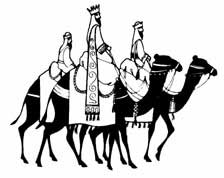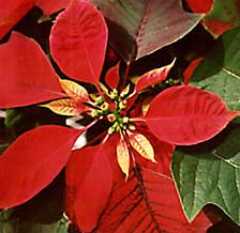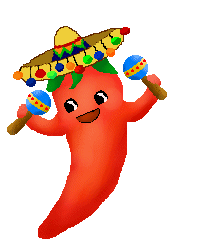 
The day of the Virgin
of Guadalupe,
Christmas and Dia de
los Tres Reyes |
|
Celebrations for the Day of the Virgin of
Guadalupe begin the week before December 12. This
fiesta is based on the legend of Juan Diego and the Virgin Mary. The
virgin Mary appeared to Juan Diego in
the year of 1531 and told him to go to the Bishop and have him build a
shrine to The Virgin Mary on the site where she had appeared to Juan
Diego. The Bishop did not believe him
so the Virgin Mary had to appear to Juan Diego again. This time she had
Juan gather roses from a stony hill
where only cacti grew and she wrapped them in his cloak. Juan was to take these to the Bishop who had refused his request
for the shrine. When Juan opened his cloak the roses
disappeared and a picture of the Virgin appeared on his cloak. The Bishop
declared it a miracle and had a church
built to honor the Virgin. She became the patron saint of Mexico. On the Day of the Virgin of Guadalupe children
visit their local church. The boys dress as Dieguitos
in memory of Juan Diego, with serapes, sandals and painted mustaches. A
huge fair is held during the fiesta and
Conchero dancers and matachin sword dancers entertain the crowd. There are twelve dances performed some of these
are "The Battle, The Cross, and El Toro" (
the bull). There are food booths and street vendor type pushcarts for
refreshments at the fiesta.
The celebrations for the day of the Virgin of
Guadalupe barely end before the Christmas season
begins. The Christmas celebrations begin on December 16 and continue
through January 6, Three Kings Day. The
Nacimiento (manger scene) is the most important part of this holiday to the Catholic families. The people have Posada (inn
or shelter) Processions to reenact Mary and Joseph
looking for a room. These are usually done by children and they continue
the procession for nine nights. The
last night is on December 24 and the procession is finally admitted to someone's home.
The people have prayers around the manger and
then the socializing begins. There is a piñata
for the children. A piñata is made of clay or paper mache and covered in
curly tissue paper, it can be any shape
or size. The youngest child is allowed to try to break open the hanging piñata first and then the others are given a
chance until it is broken. There are usually floats in the procession
on the night of December 24 and then a large firework display. The
Christmas season ends on January 6, which is the Dia de los Tres Reyes (
Day of the Three Kings). The Three
kings brought rich gifts to the baby Jesus so children in Mexico believe they will bring them gifts also. They
leave water and grass for the weary camels , and their
shoes out for the gift. In the morning the water and grass is gone and
their shoes are filled with gifts.
On January 6 many parties and celebrations have
a special cake called the Three Kings' Cake.
It is the shape of a crown with cherry candies for jewels. A tiny doll is
placed inside the cake before it bakes.
The person who finds the doll is supposed to have good luck. These three fiestas are celebrated in Latin American Countries
and in the United States in areas where large Hispanic
populations are. |
Objectives:
Students will be able to see the similarities between the holiday
celebrations in the United States and fiestas.
Students will be able to demonstrate an understanding of what a fiesta is.
Students will be able to identify five Latin American Countries on the map.
Students will be able to identify three symbols that are used during a
holiday celebration or fiesta.
Students will be able to demonstrate an understanding of how holiday
celebrations or fiestas are based on legends.
Time Required:
3
to 4 days
Vocabulary:

celebrations, fiestas, legends,
symbols, similarities, differences,
religious
Materials:
A globe
large round balloon
newspaper strips
flour and water paste
The Legend of the Poinsettia by Tomie dePaola
Nine Days to Christmas a Story of Mexico by Marie Hall Ets and Aurora
Labastida
Procedures:
- Have students share some
of the holidays they celebrate in their homes.
- Ask students if there are holidays that we celebrate in the United States that
other countries also celebrate . List what students say on the board.
- Explain to students that
a fiesta is a festival or holiday. Fiestas can be held in honor of religious holidays, national events, or community leaders. Three
fiestas that are celebrated in Mexico during the months of December and January are the day of
the Virgin of Guadalupe, Christmas, and Dia de los Tres Reyes (Day of Three
Kings).
- Give the students an explanation of these three fiestas and how they are
celebrated. Have students compare these three fiestas to holiday celebrations that are popular
in the United States.
- Pull down the flat world
map and get the globe. If possible have maps for students to use. Discuss with the students what Latin American countries are
and where they are located. Point out North America, South America, Central America
and the Caribbean Islands. Then discuss the countries found on those continents. Give students time to identify Latin American countries on the
map with a neighbor.
- Read Nine Days to Christmas
ask students to look for differences in how U.S. citizens celebrate Christmas and how those in Mexico celebrate Christmas.
- Have students write some of the similarities and difference in the way we celebrate
holidays in the United States and how people in other countries celebrate the same holidays in
different ways.
- Discuss with the
class the legend of Juan Diego and the Virgin of Guadalupe. Then read The Legend of the Poinsettia by Tomie dePaola.
- These are
two examples of what a legend is. Discuss with students the origin of
celebrations. Talk about how the Day of the Virgin of Guadalupe is based on a legend.
- Ask students if
they have special foods that they only get when they celebrate certain holidays. For example candy canes at Christmas and pumpkin
pie for Thanksgiving.
- Then divide students into groups of four or five by numbering
off.
- Have students list five foods that people in the United States eat during a
certain holiday season. After the students have listed their responses give each group a turn
to share their list with the class. Then discuss with students why certain foods are
associated with certain holidays (candy cane represents the shepherds staff).
- Discuss
with students some of the foods that are found at fiestas. Some examples are Chicken
Enchiladas, Tacos, Patacones (Fried Plantains), and Bolitas de Coco (Coconut Candies).
- Ask students what they
feel an artifact is. Discuss some of the artifacts of celebrations we have in the U.S. For example the jack-o-lantern at
Halloween and Christmas trees at Christmas.
- Tell students about the tradition of piñatas
at
the Christmas Fiesta. Have students compare and contrast similarities between the artifacts
they think of and the piñata.
- Have a space in the back of the room where a
piñata can be
made. Allow students who have free time to go to the back of the room and work on the class
piñata.
- Have the students fold their
paper into six squares and list in each square something that they learned about fiestas and how they are celebrated. Also have them
choose between a journal entry or writing a post card. They are to write their
journal entry or their post card about their attendance at one of the three fiestas we
discussed.
Evaluation:
The comparisons of how different countries celebrate the same holidays will
be assessed.
Naming and locating five Latin American countries on the map will be assessed
individually and
orally throughout the unit.
The six things students list about fiestas will be assessed.
Journal entries or post cards will be assessed.
Extension Activities:
Ancient Sites in Mexico
Mexico is a country with a rich history. It was once the home of two ancient
empires: those of the Mayas and the Aztecs. Divide students into four groups to
study these sites of Mesoamerican civilizations: Chichén Itzá, Teotihuacán,
Tenochtitlán, and Palenque. Ask each group to draw a map or a picture of the
site and to answer the following questions:
Home Learning:
Use the Internet to visit Fiesta
de Guadalupe. Read and be ready to share what you've learned.

Home |